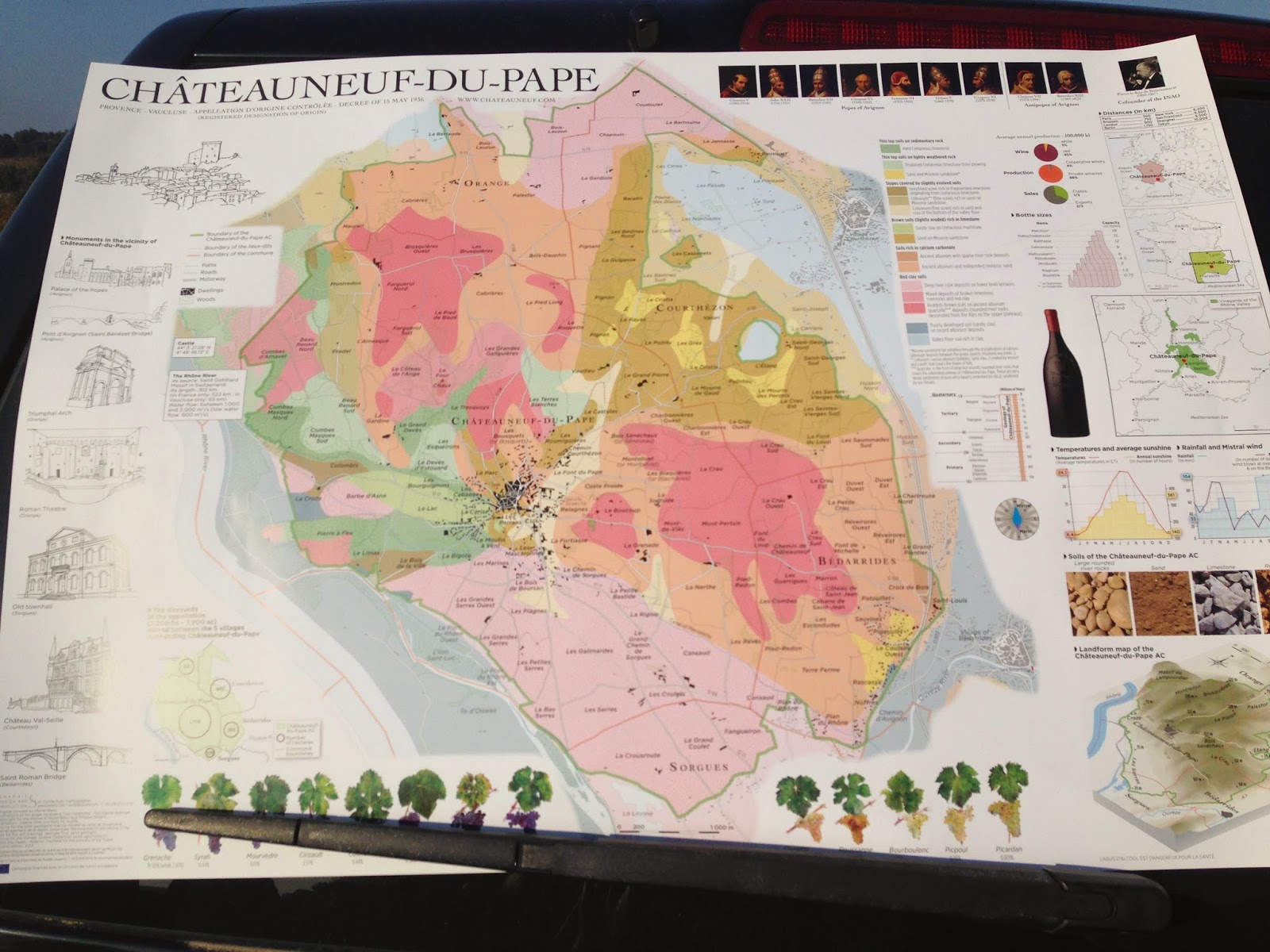I have always wanted to hold some of these stones in my hand and got the opportunity back in October of 2014 when I was honored to be among a group of bloggers invited by the Fédération des Syndicats de Producteurs Chateauneuf-du-Pape et Tavel to visit the region as part of a DWCC 2014 pre-Conference trip. The trip included one day in Tavel and one day in Chateauneuf-du-Pape and one of the highlights was the two hours spent in the CdP vineyards with geologist Georges Truc.
Today's post presents my understanding of the landscape formation and current soil conditions in Cdp and is based on the presentation of M. Truc as well as research conducted subsequent to the visit.
 |
| Geologist George Truc with KelleyMcAuliffe in background |
In attempting to build a view of the formative influences on CdP, I have previously posted on the geology of the Rhone Valley as well as the landscape of the Northern Rhone sub-region. The Southern Rhone can itself be divided into two geologic spaces comprised of the Cotes-du-Rhone appellations and the communal appellations. While focused on CdP, a lot of the geologic effects are similar for areas such as Lirac and Tavel, for example, and can stretch as far east as Gigondas.
At the beginning of the Miocene (about 24 million years ago), the area that now constitutes the AOCs of CdP, Tavel, and Lirac were a part of the Urgonian limestone peaks of which modern-day Plateau du bois de Saint Victor, and the series of limestone buttes that are visible as you approach CdP, are a part. The portions of the limestone peaks between Lirrac-Tavel and Gigondas were submerged by the Miocene and Pliocene seas and overlain by sandy molasse and sand as a result (Fanet, Great Wine Terroirs).
The uplifting of the Alps displaced a lot of material which the Rhone carried down into the areas identified in the foregoing. Successive glacial periods resulted in the Rhone down-cutting into the existing landscape leaving stony terraces at different heights, with each terrace being named after the glacial period in which it was formed. The major CdP landscape-formative occurrences are tabulated below.
Period
|
Action/Occurrence
|
Result
|
Early Tertiary Period
(66 - 37 My)
|
|
|
Miocene and Pliocene
(24 - 2 My)
|
|
|
Pliocene
(5 - 2 My)
|
|
|
Early Quaternary
(2 - 1 My)
|
Temperature drop in the glacial
Riss stage
|
|
Late Quatenary
(1 - 0 My)
|
Glacial phase in two stages
|
|
Present Day
|
Fine alluvial soil deposited on
the riverbed and surrounding plain
|
MY = Millions of years.
Data sourced from Karis, The Chateauneuf du Pape Wine Book.
In his discussion about the soils, M. Truc indicated that there were three principal soil types in CdP and we drove to each of these in order to observe and be provided with the appropriate background. The first soil type that we drove to was on the east side of CdP and was described by M. Truc as calcaire (limestone), that had been laid down in the Cretaceous period (145 - 66 million yeras ago). The limestone here is eroded and is the same age as the limestone encountered in Tavel. This soil is, according to M. Truc, best suited for whites as it imparts a salinity and minerality. It is not as well suited for reds as the tannins are not that evident and they do not realize the same power as the other terroirs.
The vines try to grow through cracks in the limestone, some of which (the cracks, that is) are filled with clay minerals. There are clay-based soils below the limestone. Clay is a very important part of any winemaking soil in France as it is key to provision of mineral to the vines
The stones drain water and extends the heat of the day into the night. Powerful wines are produced from vines grown on these stony soils. Here vines are planted at between 2500 and 4000 vines per ha.
Most of the limestone in CdP has been covered by sand or clay with the most sandy region being to the east and being a product of the Miocene era. According to M. Truc, a lot of the sand is as a result of deposition of erosion from the Alps. Sandy soils had not been considered a good winemaking terroir untill recently but is now home to some of the finest, most elegant wines as, according to M. Truc, evidenced by the wines of Chateau Rayas and Clos du Caillou.
The map shown above has been modified to align the descriptors with the soils map shown earlier.
A description of the CdP wine region will be presented in a later post.
©Wine -- Mise en abyme







No comments:
Post a Comment